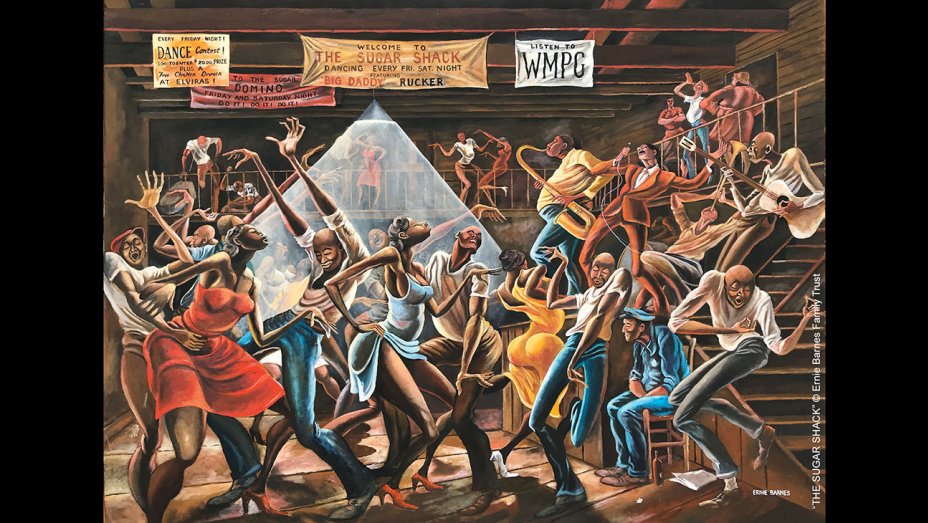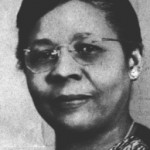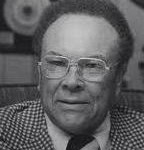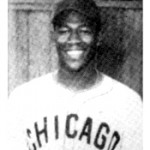The Truth Behind ’40 Acres and a Mule’
By Henry Louis Gates, Jr.
We’ve all heard the story of the “40 acres and a mule” promise to former slaves. It’s a staple of black history lessons, and it’s the name of Spike Lee’s film company. The promise was the first systematic attempt to provide a form of reparations to newly freed slaves, and it was astonishingly radical for its time, proto-socialist in its implications. In fact, such a policy would be radical in any country today: the federal government’s massive confiscation of private property — some 400,000 acres — formerly owned by Confederate land owners, and its methodical redistribution to former black slaves. What most of us haven’t heard is that the idea really was generated by black leaders themselves. (more)
The Harlem Hellfighters
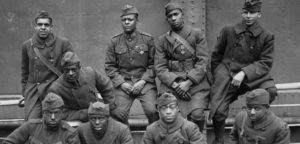 History.com — Video
History.com — Video
The Harlem Hellfighters were an African-American infantry unit in WWI who spent more time in combat than any other American unit. Despite their courage, sacrifice and dedication to their country, they returned home to face racism and segregation from their fellow countrymen.
Click here to view the six-minute video.
2019 Aya Symposium at PVAMU
“Education: THE Foundation for Civil Rights in Texas Freedom Colonies”
 The Aya Symposium, in association with the Texas Purple Hull Pea Festival, will be held on Wednesday, June 19 (“Juneteenth”), 2019 at Prairie View A&M University in the School of Architecture. Texas educators, historians, and history enthusiasts are encouraged to attend. K-12 Texas educators will receive 7 CPE credits.
The Aya Symposium, in association with the Texas Purple Hull Pea Festival, will be held on Wednesday, June 19 (“Juneteenth”), 2019 at Prairie View A&M University in the School of Architecture. Texas educators, historians, and history enthusiasts are encouraged to attend. K-12 Texas educators will receive 7 CPE credits.
On June 19, 1865, more than two years after the Emancipation Proclamation, Texas’ enslaved residents were informed of their freedom. Almost immediately, these newly emancipated Texans began to assert themselves as resourceful, innovative citizens, forming more than 540 “Freedom Colonies” throughout the state during the mid-19th through the early 20th centuries as foundations in the fight for Civil Rights for Texans of African descent.
The goal of this symposium, entitled “Education – THE Foundation for Civil Rights in Texas Freedom Colonies” will be to explore the history of the educational systems and structures in Freedom Colonies, their influence on fostering and sustaining Black civil rights in the late 19th and early 20th centuries, and their impact on African-American Texans today.
For registration and more information, visit the Aya web site, www.ayasymposium.org/.
Kareem Abdul-Jabbar: How Athlete-Artist Ernie Barnes Captured Black Culture’s “Joy and Communal Dignity”
(The Hollywood Reporter) A longtime fan and onetime subject of the NFL pro who became a renowned painter, THR’s columnist explores the “revelation and inspiration” of the late artist’s new exhibit at Los Angeles’ California African American Museum — “a testament to an artist who gave his people a voice.”
Art has a special place among people who have historically been silenced and their culture marginalized. Such sustained suppression stifles not just the outspoken voice, but can cause the oppressed to doubt they actually have anything worthwhile to say. When I was a high school student in the mid-1960s, my outrage at social injustice was articulated by activists Dr. Martin Luther King Jr., Malcolm X and Stokely Carmichael. But my pride in my African American culture and heritage was expressed by musical artists like Miles Davis and Thelonious Monk. As for the visual arts, I spent a lot of time at the Schomburg Center Library in Harlem which had a colorful mural called Aspects of Negro Life: From Slavery to Reconstruction (1934) by Aaron Douglas. It was vibrant and celebratory, and whenever I saw it I felt a surge of cultural pride. I feel that same surge of joy and communal dignity when I look upon the magnificent and masterful works in the current exhibition “Ernie Barnes: A Retrospective” at the California African American Museum (through Sept. 8).
I have a special fondness for professional athletes who, after excelling at sports, go on to be successful in the arts. It’s a swipe left on the stereotype of the cartoonish monosyllabic, monotoned, mono-talented athlete usually named Moose or Tank. But Barnes’ journey as an athlete seemed more accidental, while his journey as an artist was fervently deliberate. (more)
TIPHC Bookshelf
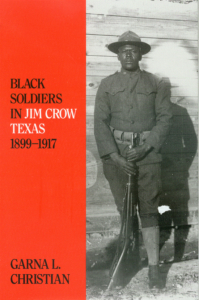 Published scholarship on black history in Texas is growing and we’d like to share with you some suggested readings, both current and past, from some of the preeminent history scholars in Texas and beyond. We invite you to take a look at our bookshelf page – including a featured selection – and check back as the list grows. A different selection will be featured each week. We welcome suggestions and reviews. This week, we offer, “Black Soldiers in Jim Crow Texas, 1899-1917,” by Garna L. Christian.
Published scholarship on black history in Texas is growing and we’d like to share with you some suggested readings, both current and past, from some of the preeminent history scholars in Texas and beyond. We invite you to take a look at our bookshelf page – including a featured selection – and check back as the list grows. A different selection will be featured each week. We welcome suggestions and reviews. This week, we offer, “Black Soldiers in Jim Crow Texas, 1899-1917,” by Garna L. Christian.
1996 Gustavus Myers Award, presented by the Gustavus Myers Center for the Study of Bigotry and Human Rights
1995 T.R. Fehrenbach Award, presented by the Texas Historical Commission
In Jim Crow Texas, black Regular Army units returning victoriously from Cuba and the Philippines collided head-on with local segregation and bigotry. As the soldiers’ expectations of dignity and respect met with racial restrictions and indignities from civilian communities, a series of violent episodes erupted.
Although confrontations also occurred elsewhere, the most notorious were in Texas, beginning with an 1899 clash between white lawmen in Texarkana and black soldiers riding a troop train west after returning from Cuba. The first truly violent episode came in 1906, when troops were accused of attacking Brownsville after civilian provocations. In 1917 a full-scale battle in Houston resulted in fifteen dead and twenty-one injured. Between 1899 and 1917, a series of other face-offs—some involving the complex relationships of blacks with local Hispanic populations—occurred when black soldiers stood up for their rights or their lives in San Antonio, Laredo, El Paso, Rio Grande City, Del Rio, and Waco.
This little-known story, never before told in full, illuminates the collision of racial discrimination with racial pride and reveals once again the petty biases, institutionalized racism, and mutual suspicions that have divided American society. But it is also a story of lofty aspirations too long delayed, of the transformation of a downtrodden race into a self-confident people, and of the noble attempt, however dangerous its means, to realize full citizenship.
Clearly written and impressively researched, Black Soldiers in Jim Crow Texas traces the relationship of the four black military regiments—the 24th and 25th Infantries and the 9th and 10th Cavalries—with white civilian communities in the period between the Spanish-American War and World War I. Drawn from previously unexploited sources, it fills a void in the increasing body of research on the black military and illuminates the magnitude of racial intolerance in early twentieth-century America. No other work has explored these issues in such depth and with such skill.
This Week in Texas Black History
May 20
On this day in 1881, Mary Elizabeth Branch was born to a family of former slaves near Farmville, Virginia. Branch received a bachelor’s degree in 1922 and a master’s degree in English in 1925, both from the University of Chicago. In 1930, the American Missionary Association appointed her president of Tillotson College in Austin, making her the first woman to head an accredited college in Texas. Under her direction the college’s facilities were improved, the library’s holdings were expanded, and the faculty size doubled. She also permitted the organization of fraternities and sororities and encouraged the formation of academic and athletic clubs. In 1944, Branch helped to establish the United Negro College Fund.
May 21
On this day in 2005 Dallas civic leader Samuel William Hudson, Jr. passed away. Hudson was the city’s first African American to serve on a grand jury. As a civil rights activist, his efforts lead to the desegregation of Southern Methodist University’s School of Theology and the admittance of black patients to Methodist Hospital. Hudson graduated from Bishop College and was the father of former State Representative Sam Hudson, III.
May 22
 Marguerite Ross Barnett was born on this date in 1942. In 1990, she became the first woman and the first African-American to hold the office of president of the University of Houston. From Charlottesville, Virginia she grew up in Buffalo, New York and earned a political science degree from Antioch College and master’s and doctorate degrees in political science from the University of Chicago. A recognized scholar in political science, she taught at Princeton, Howard, and Columbia. At UH, she succeeded in raising more than $150 million for the institution, establishing the Texas Center for Environmental Studies, and instituting the nationally renowned Bridge Program, which aided and motivated disadvantaged students to make a successful transition from high school to college.
Marguerite Ross Barnett was born on this date in 1942. In 1990, she became the first woman and the first African-American to hold the office of president of the University of Houston. From Charlottesville, Virginia she grew up in Buffalo, New York and earned a political science degree from Antioch College and master’s and doctorate degrees in political science from the University of Chicago. A recognized scholar in political science, she taught at Princeton, Howard, and Columbia. At UH, she succeeded in raising more than $150 million for the institution, establishing the Texas Center for Environmental Studies, and instituting the nationally renowned Bridge Program, which aided and motivated disadvantaged students to make a successful transition from high school to college.
May 23
On this day in 1973, Houstonian Don Robey sold Duke-Peacock Records, one of the first nationally-successful black-owned labels, to ABC-Dunhill, bringing an end to an important era in the Texas recording industry. Robey founded Peacock Records in 1949 to promote his featured artist, Clarence “Gatemouth” Brown. In 1952, Peacock merged with Duke Records which added to Robey’s roster R&B musicians such as Junior Parker, Bobby Blue Bland, Big Mama Thornton, and Johnny Ace. Robey’s Duke-Peacock Records helped shaped the sound of early rock ‘n’ roll and left a lasting imprint on American popular music.
May 24
Former Negro Leagues star and Tuskegee Airman John “Mule” Miles died on the day in 2013 at age 91 in his home town, San Antonio. During World War II, he served as a mechanic for the 99th Pursuit Squadron. After that, he played for the Chicago American Giants from 1946 to 1949 and in 1947 hit 11 home runs in 11 straight games, a feat that has never been equaled. Giants’ manager Candy Jim Taylor, gave Miles his nickname saying that he “hit like a mule kicks.” Miles played alongside such greats as Jackie Robinson, Hank Aaron, and Satchel Paige.
May 25
Pioneering journalist George McElroy, “Mr. Mac,” was born on this day in 1922 in Houston. McElroy was the first black columnist for the Houston Post, and was also the first African-American to earn a master’s degree in journalism from the University of Missouri, which he attended on a scholarship from the Wall Street Journal. McElroy began his career at age 16 earning $2 a week writing a youth column for the Houston Informer, the city’s oldest black newspaper. Years later, he became the paper’s executive editor. McElroy, the recipient of numerous honors, taught journalism at Houston’s black high schools, as well as Texas Southern University (his alma mater) and the University of Houston.
May 25
Professional basketball great K.C. Jones was born on this day in 1932 in Taylor. At age nine, he moved with his mother to San Francisco where he starred in football and basketball at Commerce High School. At the University of San Francisco, Jones teamed with Bill Russell in leading the Dons to 56 consecutive wins and back-to-back NCAA championships in 1955 and 1956. Jones also played professionally with Russell on the powerful Boston Celtics teams as a defensive standout in late 1950s and 1960s. He was also a member of the 1956 U.S. Olympic Basketball Team that won a gold medal at Melbourne, Australia. Jones won eight championship rings as a player, one as an assistant coach with the Los Angeles Lakers, one as an assistant coach with the Celtics, and two as head coach of the Celtics. He was inducted to the Naismith Memorial Basketball Hall of Fame in 1989.
Blog: Ron Goodwin, Ph.D., author, PVAMU history professor
Ron Goodwin is an assistant professor of history at Prairie View A&M University. Even though he was a military “brat,” he still considers San Antonio home. Like his father and brother, Ron joined the U.S. Air Force and while enlisted received his undergraduate degree from Texas Lutheran University in Seguin, Texas. After his honorable discharge, he completed graduate degrees from Texas Southern University. Goodwin’s book, Blacks in Houston, is a pictorial history of Houston’s black community. His most recent book, Remembering the Days of Sorrow, examines the institution of slavery in Texas from the perspective of the New Deal’s Slave Narratives.
Recent Posts
The Everlasting Light
Ye are the light of the world. A city that is set on an hill cannot be hid. Neither do men light a candle, and put it under a bushel, but on a candlestick; and it givith light unto all that are in the house. Let your light so shine before men, that they may see your good works, and glorify your Father which is in heaven. — Matthew 5: 14-16
This is the month set aside to honor…(more)
The Return of the Silent Majority
Fifty years ago, in January 1969, Richard Nixon was sworn in as the thirty-seventh president of the United States. His legacy as President was marred by the Watergate investigations and his eventual resignation from office which overshadowed the way in which he won the office. His central campaign rhetoric was designed to garner support from white Southerners (otherwise known in history as the “Silent Majority”) whose racial beliefs leaned heavily towards the support of white…(more)
Submissions wanted
Historians, scholars, students, lend us your…writings. Help us produce the most comprehensive documentation ever undertaken for the African American experience in Texas. We encourage you to contribute items about people, places, events, issues, politics/legislation, sports, entertainment, religion, etc., as general entries or essays. Our documentation is wide-ranging and diverse, and you may research and write about the subject of your interest or, to start, please consult our list of suggested biographical entries and see submission guidelines. However, all topics must be approved by TIPHC editors before beginning your research/writing.
We welcome your questions or comments. Please contact Michael Hurd, Director of TIPHC, at mdhurd@pvamu.edu.

